Savoring the Pleasures of Early Spring in Vermont
After a long snowy winter Vermonters are all eagerly awaiting the arrival of spring.
As we reach April the sun is riding higher in the sky and the days are getting noticeably longer. Indeed we are already well past the Spring Equinox (which this year occurred on March 20), that specific day on the calendar when the nighttime and daytime hours are identical. And all this extra sunlight caused the heavy snow we had in mid-March to mostly melt away in just a few days.
Up here in the mountains, many spring flowers, both in my garden as well as in the surrounding woods, wait until May before they reach their prime. But, even so, April has plenty to offer this impatient gardener.
Earliest arrivals
By late March I am keeping an eye on the bed along the southern wall of our house, the first place to see eager green shoots as they push up to greet the new season. With the direct sunlight, this bed always warms up faster than the rest of the garden—leading to a tantalizingly early display.
By mid-April the first daffodils are blooming, set off by low-growing bulbs like scilla (Scilla siberica) with bright-blue flowers like miniature hyacinths , the diminutive Glory of the Snow (Chionodoxa) with dainty blue and white flowers, as well as an abundance of snowdrops (Galanthus sp).
Meanwhile, around the back of the house beneath the serviceberry trees, several expansive patches of our native bloodroot (Sanguinaria canadensis) are nothing short of sensational. About twenty years ago now, I spied a single bloodroot flower in the underbrush along the edge of our woods. I carefully dug a small underlying piece of rootstock–with its tell-tale red sap–and planted it near the house where I would be able to see it from our kitchen window.
Today that single small sliver of rootstock has created several gigantic patches of bloodroot, some as wide as 6′ across. Early each spring I watch for the first twisted leaves to appear–they always remind me of miniature cigars– each protecting a single emerging flower-bud.
In a short time the pure white flowers with yellow centers emerge, and the sight is nothing short of amazing.
No winter lasts forever: no spring skips its turn
Hal Borland
Swelling buds bring forth spring flowers
In early April I start watching the branches of various trees and shrubs for those telltale swellings indicating that, before long, they will be leafing out or even starting to flower.
In particular the flowers of both the Sugar and Red Maple trees—which appear very early and ahead of the leaves—are an important source of nectar and pollen for some of the native bees as they emerge from their winter nests in search of food.
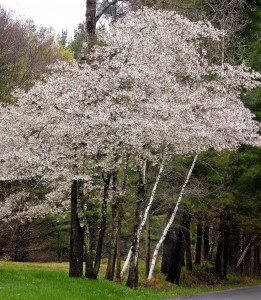
Around the third week of April the native serviceberry trees burst into bloom all along Vermont’s country roads–telling us spring has arrived!!
Serviceberries (Amelanchier arborea and Amelanchier leavis) are hardy native trees that thrive in partial shade, such as along the edges of the woods where, for much of the year, they pass almost unnoticed.
Then seemingly overnight, these diminutive trees are covered with delicate white blossoms—a sure sign that spring has arrived.
Down in the valleys this magic occurs about the third week of April—but up in the mountains it will usually come a week or so later. So, by taking a drive from one location to another, you can experience this special treat more than once each springtime.
Look for them along the hedgerows as you drive along the country roads—first in the valleys and then in the mountains.
Roadside delights
At this time of year after a long winter indoors, it is a welcome treat to spend time out of the house, taking a leisurely drive or a long walk, and savoring the new season.
And indeed I have three cherished destinations not far from where I live in Goshen which I make a point of visiting every spring. Each offers a very special floral display that can be enjoyed from the road, either on foot or in the car. Indeed, since they are all on private property, this is how they should be enjoyed!
Blue Squills
Take a walk through one of Vermont’s small towns in late April and check the gardens that you pass by. Sooner or later you will surely discover a bright green lawn or patch of groundcover bedecked with the blue flowers of Scilla (Scilla siberica). There is one along Park Street in Brandon, and another along High Street in Middlebury, both of which I visit every April.
A hillside of daffodils
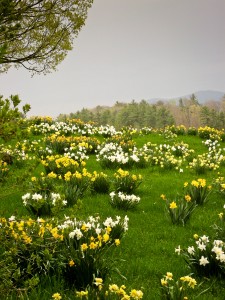 The next place I am sure to visit every year towards the end of April is Miller Hill Farm in Sudbury. For as long as I can remember each spring I have come here, just to savor the incredible sight of a beautiful hillside field full of daffodils in bloom.
The next place I am sure to visit every year towards the end of April is Miller Hill Farm in Sudbury. For as long as I can remember each spring I have come here, just to savor the incredible sight of a beautiful hillside field full of daffodils in bloom.
And, more recently, there has been an added reason to come to Miller Hill Farm. It is now owned by Carl Phelps and Nan Jenks-Jay, who have opened a delightful nursery where they specialize in native trees, shrubs and perennials—many of which they grow themselves.
The amazing trillium woods
And the third stop that I make each and every spring is along Dewey Road in Salisbury to see the beautiful rolling woodlands carpeted with great white trillium (Trillium grandiflorum). Here the owners have gently thinned out some of the understory trees and shrubs from their woods and, in so doing, they have given these wonderful native plants the space and the light they need to thrive and multiply. While these woodlands are confined to private land, you can view this wonderful sight right from the road in your car.
Woodstock woodlands
If you do indeed want to take a walk in the woods I can think of no better place than the woodlands within the Marsh-Billings-Rockefeller National Park in Woodstock. Outside the main mansion and the formal gardens you will find over 600 acres of ‘conservation landscape’—woodlands that were initially planted by Fredrick Billings, back in the 1860s, as a response to earlier wholesale clearing of Vermont’s forests to make way for agriculture.
Today this beautiful area is criss-crossed with trails which can be accessed either from the park entrance on the eastern side or from Prosper Road on the western side.
Download this map to see more details:
Cady’s Falls Botanical Gardens, Morrisville
It is over forty years since Don and Lela Avery first came to Morrisville, Vermont to follow their dream and create a unique and discriminating nursery. Here they established a destination nursery, selling many unusual plants, including a wide array of dwarf and other slow-growing conifers.
And, in conjunction with their nursery, they also developed an exquisite and intimate garden so that their visitors could experience many of their very special plants up close.
Sadly, last year Don and Lela decided the time had come to close their nursery.
But the good news is that they are keeping their very special garden open for visitors. They are calling their new venture ‘The Cady’s Falls Botanical Garden’. Visitors are welcome daily between 10:00 AM and 5:00 PM. This year Don tells me that they will probably open around May 1, after the snow has finally gone for the season.
Cady’s Falls Botanical Garden actually consists of several ‘gardens within a garden’. Stroll along the wide access path and you will quickly reach the entrance to the big lawn and surrounding beds. This space is primarily sunny and home to many lovely perennials.
But a bit further and you will reach the woodland garden which is especially lovely in springtime. Meandering paths take you past beautiful rhododendrons and azaleas as well as lower-growing and shade loving spring plants like Trillium and Woodland Phlox (Phlox divaricata).
Continue on and you will reach the gorgeous bog garden, filled with lots of different specialist plants that thrive in these conditions.
All plants are meticulously labelled, so you can make notes of specific plants you would like to grow in your own garden
All that Don and Lela ask of their visitors is that they contribute a small donation to help with their maintenance costs, so that visitors can continue to enjoy this special place in the years to come.

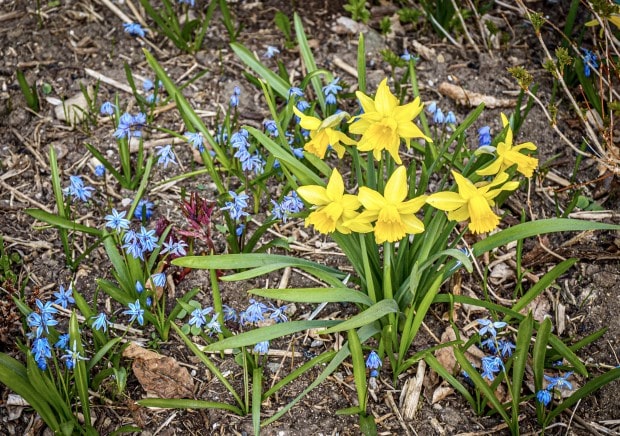






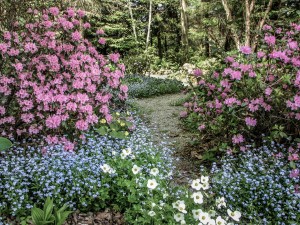
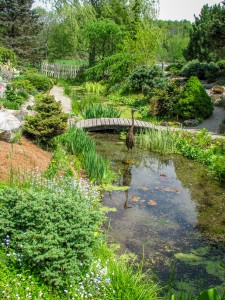
Judith, My name is Steve Breed. I live in Massachusetts, but b I ught property in Whiting VT a few years ago. I am studying through local native plants and I’ve noticed an interesting early blooming shrub that seems to grow only in my area. It is blooming now, before almost anything else. No one can identify it for me. It’s about the size of an Amalanchier but blooms earlier and the flowers are clearly different. I have pictures but don’t think I can attach one here. Could you help me identify it?